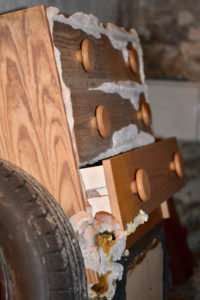How the dry rot Serpula lacrymans adapted to a new ecological habitat

By comparing genetic information from similar organisms, researchers have gained insights on why the dry rot (Serpula lacrymans) is so destructive in houses. A study involving six brown rot fungi reveals the genomic changes Serpula lacrymans has undergone in adapting to manmade environments.
Due to its aggressive capacity to damage the wood in homes, bioenergy researchers have been interested in harnessing the brown rot Serpula lacrymans towards breaking down plant mass for conversion to sustainable, alternative biofuels and bioproducts. This study lends insights on how the fungus has responded to manmade changes in its ecological habitat, adapting to thrive in built environments.
Unlike white rots, brown rots break down only the cellulose and hemicellulose, leaving the lignin behind. The brown rot Serpula lacrymans is typically found in spruce and other conifers in boreal forests. As these trees were harvested for constructing buildings, the dry rot fungus migrated indoors and across borders, adapting to thrive in manmade environments. As reported January 5, 2018 in the ISME Journal, a team led by University of Oslo scientists and including researchers at the Joint Genome Institute, a DOE Office of Science User Facility, compared the genomes of two strains of fungi Serpula lacrymans – var. lacrymans from Europe and var. shastensis from North America – against a third fungal Serpula species, S. himantioides from Europe, that was sequenced and analyzed by the JGI. The researchers found that S. lacrymans var. lacrymans has become an ecological specialist, adapted to its indoor home, and in doing so has lost its ability to harness other woody substrates other brown rots could access. While S. lacrymans var. shastensis has a similar genome, the team suggests that it has not adapted like the other strain because its local environment has been less impacted by human encroachment.
The team also did head-to-head, or confrontation experiments, involving these three Serpula fungi against three other brown rot fungi to see how the Serpula fungi have adapted in an environment with little to no competitors for resources. On wood blocks of pine, fir, and spruce, they grew a Serpula species and a non-Serpula brown rot. The researchers found that both varieties of S. lacrymans were less aggressive at colonizing the wood blocks compared to the other brown rots, though S. lacrymans var. lacrymans decomposed more spruce than the other brown rot fungi. Additionally, S. himantioides outcompeted all the brown rots it was paired with, aggressively colonizing more of the wood blocks than its partner brown rots.
The team's results reflect the evolutionary gains and losses of S. lacrymans var. lacrymans in becoming a threat to homeowners. The brown rot has adapted to thrive on the limited nutrients found in wood inside homes, and in an environment that offers limited interactions with wild relatives.
More information: S. V. Balasundaram et al. The fungus that came in from the cold: dry rot's pre-adapted ability to invade buildings, The ISME Journal (2018). DOI: 10.1038/s41396-017-0006-8
Journal information: ISME Journal
Provided by DOE/Joint Genome Institute





















